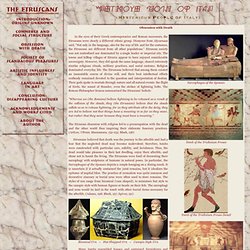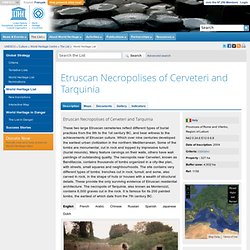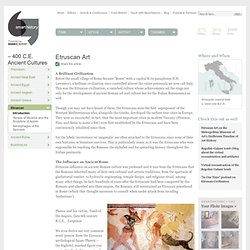

Archaic: New York Kouros. Classical: Caryatid and Column from the Erechtheion. Parthenon Sculptures. Classical: Parthenon Frieze. Room 18: Greece: Parthenon. Sculpture from the Parthenon's East Pediment. Archaic and Early Classical: Ancient Greek Temples at Paestum, Italy. THEOI GREEK MYTHOLOGY, Exploring Mythology & the Greek Gods in Classical Literature & Art. Geometric: Terracotta Krater.
Photos for personal use. History: Greeks. Hellenic Ministry of Culture and Tourism. Minoans - Timeline and Description of the Minoans. Update on the 3D reconstruction of the RG tomb « Virtual reconstruction of Regolini-Galassi tomb. We made an update of the 3D model of the Regolini-Galassi tomb, implementing the latest conclusions and adding the objects that still were missing.

Recent research by CNR-ITABC has shown that there is a floor under the current deposit of mud and that the dromos (entrance area of the grave) was still sloping downward (at a few degrees) towards the antechamber that has a level floor. This aspect has not been implemented in this reconstruction yet for simplicity. As explained in a earlier post, we choose to put the 6-headed lebes on top of the bronze holmos. The Etruscans: Obsession with death & funery practices. In the eyes of their Greek contemporaries and Roman successors, the Etruscans were clearly a different ethnic group.

Dionysus from Alycarnass said, "Not only in the language, also for the way of life and for the costumes, the Etruscans are different from all other populations. " Etruscan society was not centralized nor dominated by a single leader or imperial city. The towns and hilltop villages of Etruria appear to have enjoyed considerable sovereignty. However, they did speak the same language, shared extremely similar religious rituals, military practices, and social customs.
Religion dominated everyday life. "Whereas we (the Romans) believe lightning to be released as a result of the collision of the clouds, they (the Etruscans) believe that the clouds collide so as to release lightning, for as they attribute all to the deity, they are led to believe not that things have a meaning in so far as they occur, but rather that they occur because they must have a meaning. " Thematic Essay. Etruscan Necropolises of Cerveteri and Tarquinia. Etruscan Necropolises of Cerveteri and Tarquinia These two large Etruscan cemeteries reflect different types of burial practices from the 9th to the 1st century BC, and bear witness to the achievements of Etruscan culture.

Which over nine centuries developed the earliest urban civilization in the northern Mediterranean. Some of the tombs are monumental, cut in rock and topped by impressive tumuli (burial mounds). Many feature carvings on their walls, others have wall paintings of outstanding quality. The necropolis near Cerveteri, known as Banditaccia, contains thousands of tombs organized in a city-like plan, with streets, small squares and neighbourhoods. Nécropoles étrusques de Cerveteri et de Tarquinia Ces deux grandes nécropoles étrusques reflètent divers types de pratiques funéraires entre le IXe et le Ier siècle avant J.C. et comptent parmi les plus beaux témoignages du monde étrusque, cette civilisation urbaine du nord de la Méditerranée.
المقابر الأترورية في تشيرفيتيري وتاركينيا. Etruscan Art. A Brilliant Civilization Before the small village of Rome became “Rome” with a capital R (to paraphrase D.H.

Lawrence), a brilliant civilization once controlled almost the entire peninsula we now call Italy. Taidehistorian sanasto. Site du Pont du Gard. Watering Ancient Rome. Posted 02.22.00 NOVA Peter Aicher, an Associate Professor of Classics at the University of Southern Maine, has spent years studying the graceful arches and ingenious plumbing of Ancient Rome's vast water distrubution system.

In this interview, he describes how the Romans developed this elaborate system, which included aqueducts 60 miles long. Roman architects and hydraulic engineers built the magnificent water-transporting bridge known as Pont du Gard 2,000 years ago. Enlarge Photo credit: © Samo Trebizan/iStockphoto An Empire Built on Water NOVA: I thought we'd begin by looking at the big picture. Peter Aicher: The Romans could not have built cities as big as they did without aqueducts—and some of their cities wouldn't have existed at all. It also would be impossible to imagine Rome, which had about 1,000,000 people at its peak, without its large aqueducts. Their society would have been very different without imported water. How did they find these water sources? It was a quasi-science. Britannica Online Encyclopedia. Roman Portrait Sculpture: Republican through Constantinian.
POMPEJI - Marcus Lucretiuksen talo. Hellenic Ministry of Culture and Tourism. Hellenistic: The Pergamon Altar. Hellenistic: Nike of Samothrace. Ancient Greece - The British Museum. Polykleitos, Doryphoros (Spear Bearer) Late Classical: After Praxiteles, Venus (Roman Copy) Classical: Myron, Discobolus (Discus Thrower), Roman copy of an ancient Greek bronze. Ancient Greece - Gods and Goddesses - The British Museum. Ancient Greece - The British Museum. 10 Most Famous Greek Temples. The most important and widespread building type in ancient Greece was the temple. The first stone temples appeared some time during the early 6th century BC and began to appear in large numbers in the next century. The purpose of a Greek temple was usually to house a cult statue or emblem.
Religion did not require people to gather inside the temple to worship, and their temples were primarily monuments to the gods.